Okay, try to wrap your head around this scenario: You’re growing up during the height of the rock ’n’ roll era. Legendary bands like the Beatles, the Rolling Stones, the Who, and the Kinks are at their creative pinnacles—and because of this, the electric guitar is the most popular musical instrument in the world. Yet, not only are you unable to purchase any of these records—or any type of Western music—but you also can’t listen to it on the radio or television because it’s banned by the government. If you’re lucky, you’ve scrounged up a lo-fi copy of a copy of some sort of rock music, but to avoid dire consequences you only listen to it in the privacy of your home.
Meanwhile, thousands of fine guitars are being produced and sold around the globe, but there are virtually none in your country. You’ve heard whispers of a few people playing rock music with electric instruments, but seeing no evidence of it yourself, you figure it’s either an incredibly underground phenomenon or just a rumor. And on the off chance you do somehow manage to find an electric guitar, it will cost you extravagant sums to purchase. Even then, you’ll still have to contend with the fact that widespread, government-sanctioned slogans warning against the evils of rock and jazz will almost certainly cause family, friends, and audiences to see you as traitorous to your country if you play any music resembling those American styles.
But then something very strange happens. After banning all this for so long that the electric-guitar boom has actually begun its decline, the powers that be suddenly and rather mind-bogglingly decide electric-guitar music should be encouraged. Better late than never, right?
But here’s the catch: The government will oversee design and manufacture of the electric guitars you’ll have access to. And to make sure aspiring players retain a unique national identity, the instruments won’t really be like the popular models selling throughout the world in any substantive way. Oh, and by the way, no one in your country really knows how to build an electric guitar, but don’t worry—the government will just repurpose current factories, employees, and engineers!
All of this may be hard to fathom for those who grew up in a place where electric guitars not only symbolized creative freedom, even rebellion, in the abstract, but also offered an extremely diverse concrete means of artistic self-expression—a place where you could either rally around the unique looks, features, feel, and tones of a single iconic brand, or save up your money and cherry-pick a variety of instruments to create a formidable arsenal of specialized guitars. But it was in just such a climate that the first electric guitars in the former Union of Soviet Socialist Republics were born.
Space Race Tools for the People
The first Soviet model, eventually named the Tonika, was made in the late 1960s. And for a few years this was the only choice. Rock music was mostly banned in the U.S.S.R. during these early days of guitar making, so the question is often asked, “Why produce electric guitars in the first place?” Apparently there was a feeling among those in power that the country should compete or catch up with the West in all areas related to technology. But amplified music was also becoming more and more popular, even if it wasn’t so much in the frowned-upon genres. Thus began the collective efforts of Soviet engineers and industrialists.
The Tonika was a guitar “for the people”—and it was some kind of guitar! The rationale for the original design is still somewhat of a mystery, because it is such an odd-looking instrument. I’ve heard many players proclaim it the ugliest guitar ever produced. But in at least a couple of ways, the Tonika sort of became the blueprint for all Soviet guitars: Its build clearly prioritizes durability, and its looks and features exhibit a radically futuristic, Space Race-era bent. It really is a crazy guitar—overengineered in some ways, seriously lacking in others. I’m only half-joking when I say the instrument’s designers and buyers probably saw it as a bonus that the guitars could do double-duty as sledgehammers and/or be burnt for heat after they’d outlived their musical usefulness.
The Tonika’s seemingly strange approach to guitar making was emblematic of the times and culture. Other than a few enthusiasts, luthiers did not really exist in the Soviet Union. And the ones who did worked in virtual isolation. As a Soviet stringed-instrument enthusiast, you were more likely to either make your own electric guitar (often called a samopal, or “machine gun”) or play the balalaika. There was some guitar-making knowledge to be found at the Musima factory and a few other factories spread far and wide in former East Germany (which was under Soviet control from 1949 to 1990), but for reasons unexplained, Tonika designers often looked to Japan and Italy for creative inspiration instead. As for functionality, it seems that was either overlooked or, more likely, simply not understood by the designers—remember, they had no experience with the instrument or the musical genres typically played on an electric.
During the 1970s, ’80s, and ’90s, several more Soviet guitar models were designed and produced, and the builders did get better at their craft—but only in small degrees. Prominent models included the Aelita, Ural, Formanta, Stella, Krunk, Elgava, Maria, Accord, and Tonic. All were produced by the state, and many of them were simply named after the factories where they were built. The designs were sometimes cool and sometimes bizarre, but the real problem was how they were assembled: The individual guitar parts often featured acceptable workmanship, but the overall assembly process allowed for little to no quality control, ostensibly because they were viewed as tools rather than a conduit for self-expression. Without finer instruments to serve as a standard, Soviet-era guitars seemed to be out of date even as they were rolling off the production line. Isolationism combined with political leaders making production decisions led to rather crude-playing guitars. The wood came from the furniture factory, the electronics came from the radio factory, and after everything was assembled it was never really tested or properly set up—and don’t complain about it!
Here are three of Russia's more unusual designs (left to right): Formanta, Aelita, and Tonika.
Labors of Love and Patience
Despite all these shortcomings, players in the former Soviet republics were thrilled to have access to these new guitars. At least they had something that looked and at least somewhat played the part, even if each one cost around 180 rubles (about two-months’ salary). That said, playing them must have been a lesson in diligence. Because the instruments were basically designed and made from scratch by people with no previous guitar-lutherie expertise, the playing experience could be straight up dreadful: String action was often very high, intonation was off, and there was minimal ability to make any sort of adjustments to alleviate these concerns.
Bodies and necks were typically made of birch and beech, and the bodies were often painted in a thick lacquer that made the guitars not just tough and durable, but also less resonant. And in an ultimate irony of resource allocation, early fretboards often featured fine ebony wood, but the frets (which were simply hammered in without any glue) were usually made of rough brass—which wears down much, much faster than fretwire alloys used elsewhere.
In addition, Soviet guitars on the whole have developed a reputation for being very heavy, though in reality they tend to fall in the 6–8-pound range. So it’s not so much that they weigh a lot, it’s more that they often feel unbalanced and clunky due to their heavy necks and oddly sculpted bodies.
Then there’s the electronics, which were often very good in terms of build and component quality, but weren’t very practical for use in guitars. Many of the people working on this aspect of the guitars’ design were radio engineers who might have been making military equipment only a short time before being tasked with pickup production. This meant the electronics were often weak sounding and featured unnecessary filtering that didn’t do any favors for the instruments’ plugged-in tones.
Given all this, it probably goes without saying that maintaining and optimizing Soviet-era guitars is a true labor of love and patience. Repairing and setting them up was and is a baptism by fire. The real trouble areas are the necks and frets. Fretboard radius is usually all over the place, and the frets always seem to be either in need of replacement or tamping down. And finally, the truss rods are usually too underpowered—even drastic adjustments barely budge the necks’ thick wood. Purportedly, Soviet build methods did change a little as the years wore on, but many players argue that the quality of the guitars got worse, not better.
Red Dawn?
Today players in former Soviet republics or Soviet Bloc countries look upon these guitars with either fondness or disdain—or perhaps a bit of both. Thousands of them were made over the years, so they’re ubiquitous. Their history and designs (or at least aspects of them) are appreciated by many, though most probably prefer the more playable and diverse instruments now available from outside the country.
On the flip side, over the past 10 years there’s been a marked increase in interest in Soviet-era guitars outside their homeland. As with vintage motorcycles, radios, toys, and cars, guitarists the world over have begun to appreciate the artistic sense and design aspects of these quirky axes from the East. They regularly appear in online auctions all over the world, and as with popular Western guitars of yesteryear, there are online and offline appreciation groups where people reminisce about the old days and attempt to catalog the various models for posterity. One of these enthusiasts, Dmitrii Feklinov, was a wonderful source of information for this article. (Thanks, Dmitrii!)
As a longtime collector of strange, wonderful old guitar gear (check out my site, DrowningInGuitars.com), I have always found it interesting how design can represent the artistic sensibilities of a culture and time. If you view early guitar design as an art form, then it becomes easy to see where creative inspiration is cultivated. Let’s take a closer look at a handful of my favorite Soviet-era models that, for better or worse, offer a glimpse into a musical time and space that has all but disappeared with the Berlin Wall.
Click to learn about—and hear—these Russian treasures:
Tonika | Aelita EGS 650
Ural 650 | Formanta Solo II
The first Soviet-made electric guitar was the Tonika shown here. Manufactured in multiple locations from the late ’60s till the early ’80s, it featured Guyatone-inspired fretboard inlays and pickups, and a multi-pin DIN output jack.
Tonika
The original Soviet solidbody, this design was produced from the late 1960s up to the early 1980s. Initially designed and made in Leningrad (now known as Saint Petersburg), this particular variation was made at the Sverdlovsk (Ural) Keyboard Factory from 1971 to 1977. It is estimated that the factory churned out around 10,000 of them.The Tonika doesn’t appear to have any influences from the U.S., although—like almost all Soviet-era guitars—it does use a Fender-style scale of 25.5", so who knows? The most obvious outside influence is evident in Tonika pickups and neck markers, which are very similar to Japanese Guyatones from the early 1960s. This model features typical volume and tone knobs, as well as a rotary pickup selector. The output jack is a multi-pin DIN plug—a Soviet industry standard for many years.
The neck has a comfortable, slightly thick profile, and the radius seems small and tight. They feel similar to the early Japanese Kawai guitars that Hound Dog Taylor favored. There’s acceptable action in the first five frets, but the ebony fretboard has a rough-cut feel with very raw fretwork.
be burnt for heat.
Like many subsequent Soviet electrics, Tonika bodies were mostly made from birch, and the necks from beech wood. These were painted using a very thick lacquer, almost always black. There’s no adjustable truss rod.
The Tonika tremolo is a spectacle of original design and engineering. It features a heavy piece of metal recessed into the body and a cam-style mechanism whose range of movement is small, yielding only subtle pitch shifts that throw the guitar out of tune without too much effort. The tuners, however, are of acceptable quality, and the inscribed sparkle pickguard is pretty awesome.
Plugged in, the Tonika can yield some good tones with the aid of a boost or overdrive. That said, there’s some extraneous noise at higher volumes, and because each pickup as a whole can’t be adjusted for height (you can only raise or lower pole-piece screws), tonal balance is hard to achieve.
About 7,000 Aelita EGS 650s (top)—which were heavily influenced by Teisco ET-200 “Tulip” solidbodies (bottom)—were made at Russia’s Rostov-on-Don factory from 1974 to 1980.
Aelita EGS 650
Made between 1974 and 1980, the Aelita EGS 650 was one of the first models made at the Rostov-on-Don factory in Russia. During that period, about 7,000 were produced. Several design cues—such as the overall shape, the pickups, and the tremolo—suggest that it was highly influenced by the extremely popular and affordable Teisco ET-200 (aka the Tulip) made in the late 1960s and early 1970s, when Teisco was owned by Kawai of Japan.But while ET-200s are very light and thin, even fragile feeling, the EGS 650 is nearly twice as thick and heavy, with much harder body lines. And whereas the Tulip has softer curves that complement the flower-engraved pickguards, the Aelita has more angular sculpting and an industrial feel, all of which leads me to believe the Soviet clone was inspired by photos rather than close inspection of an actual Teisco.
EGS 650 electronics feature an interesting array of knobs and buttons similar to 1960s Italian guitars: Each pickup has its own on-off button, and three more buttons engage preset EQ settings—all of which sound poor. The pickups are weak, and as with the Tonika, filtering is abundant. By replacing the existing wiring with a more organic, point-to-point approach, you can get some interesting lo-fi tones out of these guitars.
the bar to move.
But even then, the guitars are limited in tone and output. Meanwhile, the surface-mounted tremolo, which also seems inspired by the popular Kawai unit of the time, uses a seemingly industrial-strength spring and requires quite a tug on the bar to move.
Some players might notice that the EGS 650’s pearloid headstock overlay is also reminiscent of ’60s Italian electrics. There’s also a polished metal cover over a port yielding access to an adjustable truss rod. Meanwhile, back at the body, the bridge can be adjusted for both height and intonation—although the range of movement is minimal. Such features, as well as the inclusion of bridge covers and a mute bar, must have made the guitar seem like a real improvement over early Tonika guitars. But in reality, Aelitas were often even rougher in terms of playability.
The red-to-green-burst Ural 650 shown here—which was made between ’76 and ’80 in Sverdlovsk, Russia—is something of a time capsule, complete with the original vinyl-and-textile bag, mint-condition plastic strap, and paperwork. It has a thin mahogany veneer covered in about 1 mm of clear polyester varnish, and its brass frets and odd fretboard radius make for a strange feel, though it’s definitely a playable instrument.
Ural 650
Urals are probably the most common vintage guitars in the countries of the former Soviet Union—it seems most guitar-playing youth who grew up during this interesting period owned one at some point. Aesthetically, the guitars were inspired by Yamaha’s SG-5 from the late ’60s, which was considered groundbreaking at the time both because of its radical shape and its high-quality build, components, and sounds. Apparently some of the designers at the Ural factory had access to a few Yamahas, and they decided to pretty much just flip the body shape and fairly closely mimic the headstock, bridge, and vibrato system. Probably the most unique visual element on 650s is the diverse array of pickguard options: You can find versions with green, white, brown, and gray mother-of-bowling-ball, but there are also wonderfully garish red- and gold-sparkle pick plates, too.
The Ural 650 clearly borrows several design elements from Yamaha’s late-’60s SG series. As you can see from this super-clean 1967 SG-5A, the 650 flipped the body outline and copied the headstock shape and vibrato system.
The 650 was manufactured at the Sverdlovsk Ural factory, a woodworking plant that focused on simple furniture during the early 1900s but expanded to include pianos and acoustic guitars in the late ’50s. About 25,000 Ural 650s were made from 1976 to 1980. Again, they primarily featured beech timber, as well as ply construction borrowed from furniture building. About 66,000 slightly different 650s were also made at Sverdlovsk from 1980 to 1995, with the main difference being the pickups. Both styles sound good, but the best-sounding Soviet guitar I ever played was a red-finished, red-sparkle-guard model from this later period. Once you remove the electronic filtering, the pickups in newer Ural 650s come alive. They sound edgy, with a hint of a wonderful, echo-like quality—and when you add some fuzz, you get this fantastically controllable feedback.
Even so, while Urals look like really cool instruments, when you go to play one the warts pop out. Like so many other Soviet guitars, they have all sorts of uneven playability issues. As with the Aelita EGS 650, two sets of buttons yield an awkward means of selecting the single-coils and a trio of even more awkward and muddy-sounding EQ profiles. Meanwhile, the solid-feeling tremolo, which looks almost exactly like the smooth-performing Yamaha unit, appears much nicer than it operates. The arm and socket are fine, but it does not stay in tune well with use.
More expensive than other Soviet guitars, the Formanta Solo II offered built-in fuzz and a superior tremolo system.
Formanta Solo II
The Formanta Solo II is an awesome example of Soviet craftsmanship made at the Belarusian Industrial Association factory in Borisov, Belarus. There were a few variations of the Formanta, and about 7,000 guitars like the one shown here were made from 1985 to 1992. These Formantas were much more expensive than other Soviet guitars, and so had a bit more cachet. You had to have some money to own one of these!Formanta guitars feature sculpted edges, a smooth feel, and a more reasonable weight. They also came in some ultra-cool color combinations, including pink, blue, and silver. Solo IIs have a built-in fuzz circuit (the Solo I has a phaser) powered by a 9V battery tucked into a cavity under the neck-heel plate.
I’ve only heard the fuzz-circuit Solo II, and man, it is gnarly! It sounds like an old Electro-Harmonix LPB-1 but with more edge and treble. The pickups are a little underwhelming, but they have this interesting zing quality that translates pick attack and dynamics very well, which makes them a close second to the Ural pickups.
Meanwhile, the Solo II’s tremolo is probably the best of all the Soviet guitars I’ve played. The blade-shaped handle is comfortable in the hand, and the whole unit actually works well. As for the neck, it’s chunky and the typical lacquer finish gives it a slightly sticky feel. But the strangest thing is how the profile goes from a smooth C shape starting at the body joint and then morphs to a squared-off feel in the “cowboy-chord” region. And when I say “square,” I mean it—in that area the profile is literally like what you’d see on a lap-steel neck!




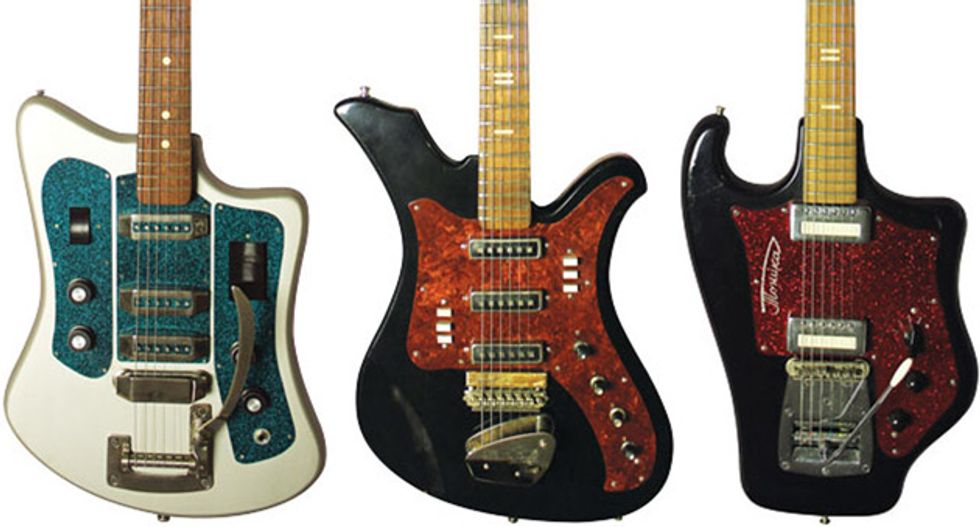

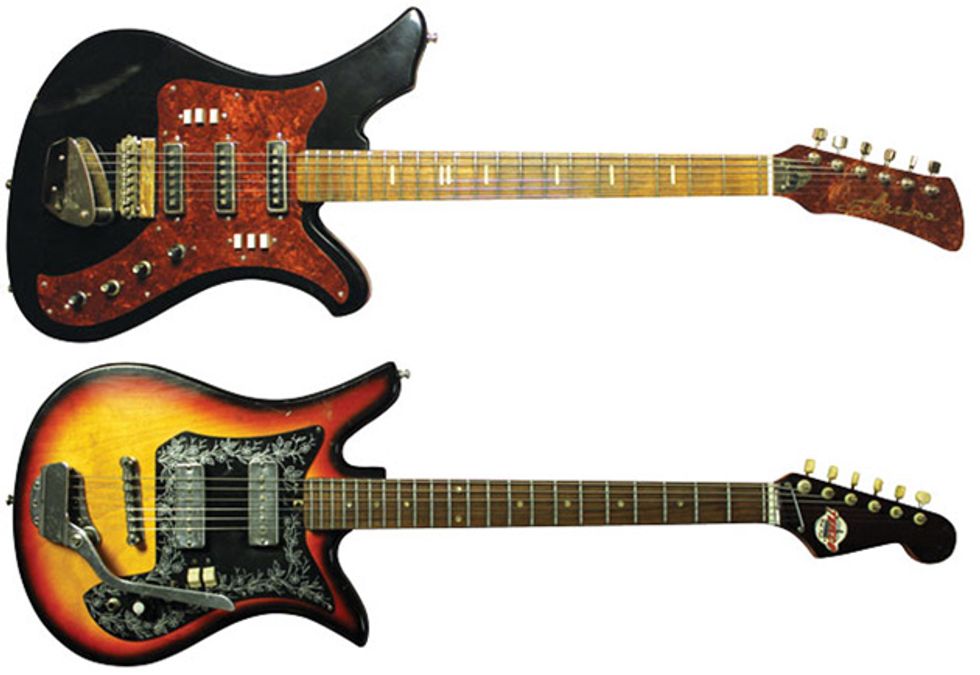
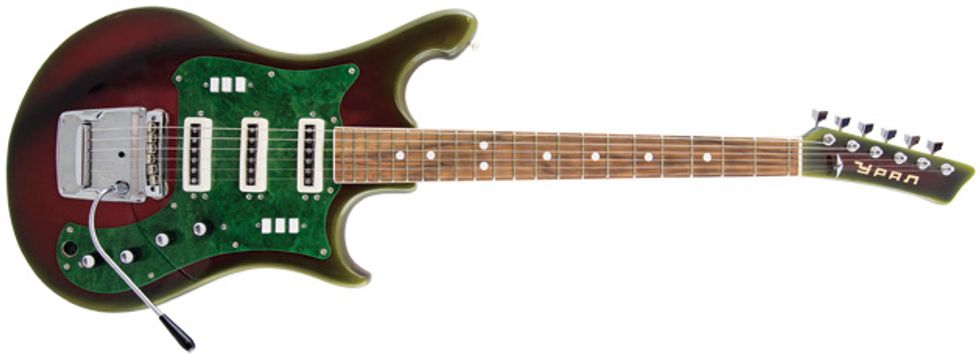
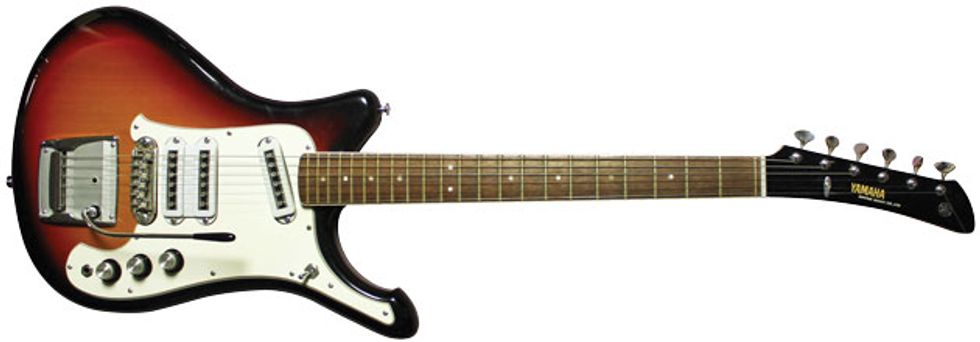
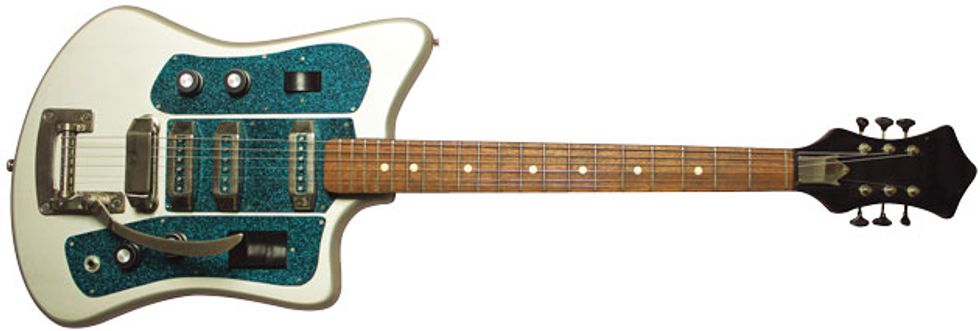




![Rig Rundown: Russian Circles’ Mike Sullivan [2025]](https://www.premierguitar.com/media-library/youtube.jpg?id=62303631&width=1245&height=700&quality=70&coordinates=0%2C0%2C0%2C0)

















